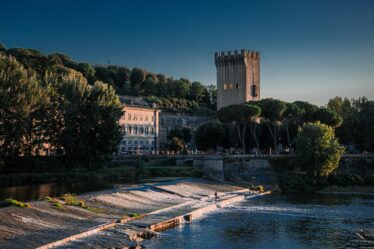
As the weather cools, Tuscan cuisine comes into its own. Many warming meals are regional, enabling seasonal produce to flourish. Seasonality, quality, and authenticity are cornerstone principles of Tuscan cuisine, but the abundance of gastronomical options can make it difficult to know where to go for the real thing and how to make an informed decision. These are the same questions posed and answered by the BuyFood Toscana 2023 event, which for the fifth year in a row has shone light on quality Tuscan products, the criteria used to evaluate them, and the environmental and production elements that distinguish them. BuyFood Toscana strives to promote understanding of the land and its produce by bringing producers and purchasers together.
The stamps of DOP (Denominazione di Origine Protetta) and IGP (Indicazione Geografica Protetta) show that a product has been verified as coming from a specific region, bearing characteristics that derive from the environment and the manufacturing process, with at least one phase conducted locally. Tuscany alone offers an offering of 90 DOP and IGP certified products, with an economic power of 1.361 million euro, representing 30% of the region’s total agricultural value, a full 9% higher than the national average.
As such, the Tuscan agricultural powerhouse deserves to be protected because it is sustained by many small family-run businesses that take pride in their work. BuyFood Toscana’s agenda includes promoting economic sustainability, assisting customers in trusting the excellence in which they invest, and supporting the rural economy in a market rife with large-scale manufacturing and counterfeits of genuine products. Because the companies represented rely on the unique characteristics of the local area, environmental and economic sustainability are inextricably linked. In reality, organic farms account for 14% of all agriculture in Tuscany, the highest proportion of any area in Italy.
Identity, history, and tradition are not flung around carelessly; their use here is justified. When regional cuisine has been evolved over centuries, you can be sure that these habits have been tried and proven, as have the manufacturing processes, which are frequently strikingly unchanged today. Choosing regional oils, cheeses, and meats is a unique way of understanding the region’s agricultural background and tasting the food that has driven towns like Florence throughout its evolution.
This year’s series of activities included visits to specific producers to learn about their products and manufacturing methods, bringing the “farm to fork” concept to life. Caseificio Il Fiorino, a multi-award-winning producer of Pecorino Toscano, was among them. The cheese-maker is based in Monte Amiata and only utilizes milk from sheep pastures in Maremma within a 40-kilometer radius of where the cheese is fermented and matured. that’s not exactly “km0,” but that’s as near as it gets. The cheese makers monitor the process at each stage, adding rennet, pressing the curds by hand, and rotating the rounds between the several maturing chambers to give each kind a distinct flavor.
The end result is a delicate and distinct cheese that is local to this region and has been developed over ages. The many types differ in maturing methods and durations, ranging from 20 days for young cheeses to four months minimum for mature cheeses, as well as added flavorings such as truffle and saffron. It goes without saying that the cheeses speak for themselves, but if that isn’t enough, the honors and certificates that cover the walls of their headquarters in Roccalbegna attest to their unrivaled quality.
In keeping with the season, extra attention was paid to the chestnuts grown in the Castel del Piano region. Mirco Fazzi runs one of the area’s largest chestnut-growing firms. He is at the core of the enterprise, collecting edible nuts and managing roasting, which takes place in a stone-brick building in the orchard. After forty days, the chestnuts are transported to the adjacent town of Seggiano, where they are crushed into flour by a stone mill powered by the river’s torrents. It’s a long cry from the big plants where our food is over-processed. This is food at its purest form.
Seggiano is also known as “the olive oil town” because of the number of olives produced and pressed there, yielding DOP and IGP certified oil. Because of the particular microclimate in Seggiano, where the trees have adapted to tolerate snow, the olives produced are smaller, but yield more than other varieties. Ten Seggiano growers formed a cooperative five years ago to preserve the quality and local history. Visitors can take a guided tour of the town, which serves as an open-air museum and includes the historic city hall, 18th-century oil presses, and a modern-day mill. The producers’ enthusiasm is visible in their work, and during the harvest season, which lasts from November to February, team members work ten hours a day.
If you want to have a very nice experience with food you could participated at our tour. we are running a Free Walking Tour of Florence that start from Santa Maria Novella Square. Book your tour, and ask at our guide about the best place where you could try and by typical traditional food from Tuscany.



